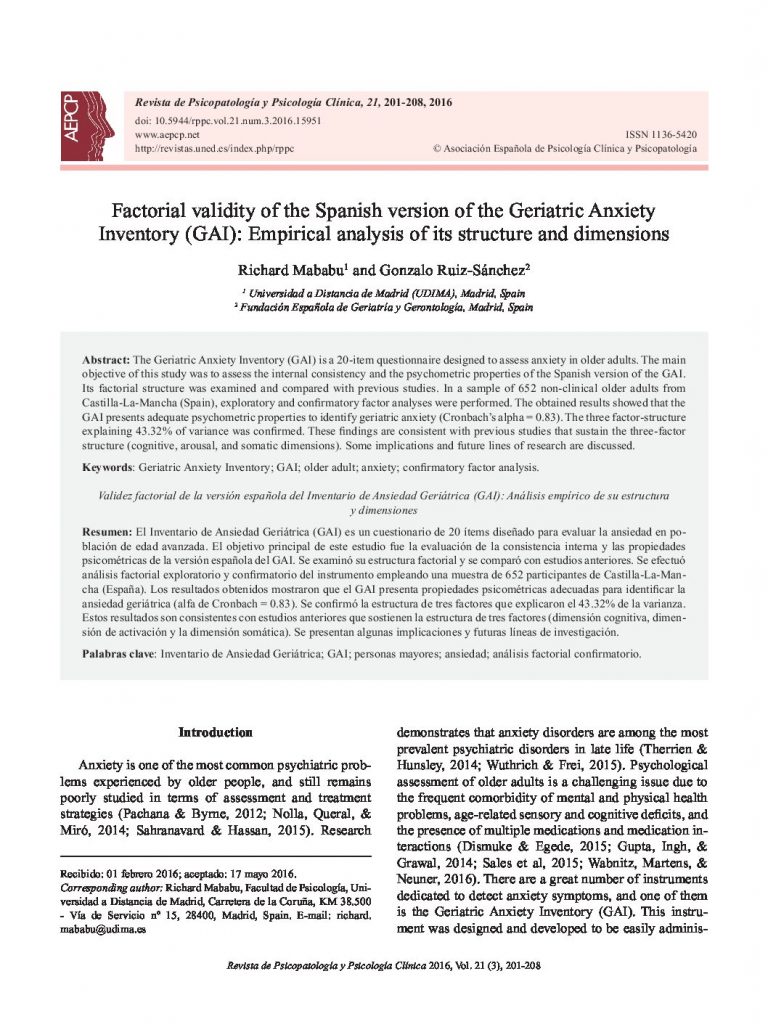Factorial validity of the Spanish version of the Geriatric Anxiety Inventory (GAI): Empirical analysis of its structure and dimensions.
Factorial validity of the Spanish version of the Geriatric Anxiety Inventory (GAI): Empirical analysis of its structure and dimensions.

- Efficacy of transdiagnostic cognitive-behavioral therapy for anxiety and depression in adults, children and adolescents: A meta-analysis.
- Bipolar remitted patients show emotionrelated bias in memories of lifelike events: A study based on the virtual reality paradigm.
- Validación del Cuestionario Tridimensional para la Depresión (CTD) en población venezolana con enfermedades crónicas.
- Factorial validity of the Spanish version of the Geriatric Anxiety Inventory (GAI): Empirical analysis of its structure and dimensions.
- El continuo de la psicosis: Evidencia psicométrica.
- Psicopatología de las compulsiones de lavado en el trastorno obsesivo-compulsivo: No todos los pacientes lavan por los mismos motivos.
- Burnout subtypes and their clinical implications: A theoretical proposal for specific therapeutic approaches.
- Profesor Dr. Vicente Pelechano Barberá (1943-2016)
- Remedios González Barrón e Inmaculada Montoya-Castilla (Coords.)(2015): Psicología Clínica Infanto-Juvenil
- Información sobre los criterios de calidad de la Revista de Psicopatología y Psicología Clínica.
The Geriatric Anxiety Inventory (GAI) is a 20-item questionnaire designed to assess anxiety in older adults. The main objective of this study was to assess the internal consistency and the psychometric properties of the Spanish version of the GAI. Its factorial structure was examined and compared with previous studies. In a sample of 652 non-clinical older adults from Castilla-La-Mancha (Spain), exploratory and confirmatory factor analyses were performed. The obtained results showed that the GAI presents adequate psychometric properties to identify geriatric anxiety (Cronbach’s alpha = 0.83). The three factor-structure explaining 43.32% of variance was confirmed. These findings are consistent with previous studies that sustain the three-factor structure (cognitive, arousal, and somatic dimensions). Some implications and future lines of research are discussed.
El Inventario de Ansiedad Geriátrica (GAI) es un cuestionario de 20 ítems diseñado para evaluar la ansiedad en población de edad avanzada. El objetivo principal de este estudio fue la evaluación de la consistencia interna y las propiedades psicométricas de la versión española del GAI. Se examinó su estructura factorial y se comparó con estudios anteriores. Se efectuó análisis factorial exploratorio y confirmatorio del instrumento empleando una muestra de 652 participantes de Castilla-La-Mancha (España). Los resultados obtenidos mostraron que el GAI presenta propiedades psicométricas adecuadas para identificar la ansiedad geriátrica (alfa de Cronbach = 0.83). Se confirmó la estructura de tres factores que explicaron el 43.32% de la varianza. Estos resultados son consistentes con estudios anteriores que sostienen la estructura de tres factores (dimensión cognitiva, dimensión de activación y la dimensión somática). Se presentan algunas implicaciones y futuras líneas de investigación.



